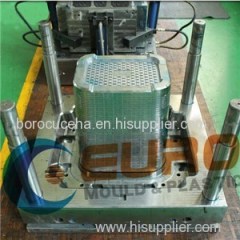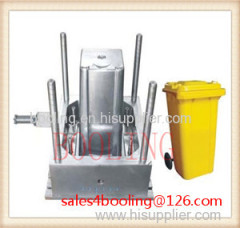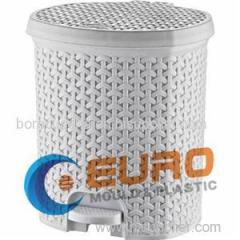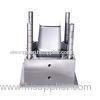
Swing Top Dust Bin Mould
Company Profile
| Location: | ningbo, Zhejiang, China (Mainland) |
|---|---|
| Business Type: | Manufacturer |
| Main Products: | Plastic Injection Mould, Plastic Injection Tool, Rigid Packaging Mould |
Product Description
1.Product name: Swing Top Dust Bin Mould2.Part material: PP3.Mould cavity: single cavity 4.Mould base: S50C,Website:http://www.europlasmould.com, P20, LKM / DME standard 5.Core & cavity: P206.Runner: cold runner or hot tip from DME, YUDO or as per client's request7.Mould finish: polish and logo engraved8.Mould life: 500k ~ 800k shots9.Samples and videos for mould trials available for clients to check10.T1 time: 35- 45 workings after confirmation on the mould drawings 11.Mould part 2D drawings to be sent with mould shipment, 3D drawings to be sent via mail to clientsWhy Choose US? Not all mold manufacturers are alike Euro Mould who takes priority in mold quality. A comparison below is made between our well-designed, solidly built moulds for reliably good quality products at lowest cost and a low cost mould for the same products after operating for relatively a short time. The difference is obvious.Subject Mold (A)- Euro Mould Mold (B) 1.Concept & Design Conceived from start with high productivity and lowest cost product in mind. Much time is spent on the mold concept before starting the actual design, or beginning to cut steel.Little if any thought has been given to the mold, except getting the shape of the product right, at the lowest possible mold cost.2.Runner Systems Much thought is given to decide on the most suitable runner system, the gating, cooling, and ejection of the products.As long as the mold can produce the desired product, even only for a short time, it is considered acceptable.3.Mold steel selection Mold steel selection is appropriate for the expected life and performance of the mold and often, the best quality steels and other materials are selected, without too much concern about the added cost. We keep to our promise to our customers for the materials specified and agreed upon, for which we can show our bill of purchase order.A lower grade steel is used for the plates with lower price, and cost of materials and mold components is a serious consideration as to save cost for maximal profit.4.Mold hardware Careful consideration is given to select the best quality of (purchased) mold components to ensure trouble-free operation.Leader pins are often too short and too slender, just long enough to engage to LP bushings. They deflect easily and do not ensure proper alignment of the mold halves. Tapers are usually too short, wear soon, and do not hold the cores aligned with the cavities.5.Strength of materials The strength of materials used in the mold is properly engineered. This applies typically to the strength of cavities and cores to contain the high injection pressures and the size of mold plates to support both cavities and cores.Cavities and cores are often not strong enough and expand or deflect when subjected to high injection pressures. The mold plates are thin, just strong enough to hold the components in position.6.Strength of supports Support plates are adequately heavy and sufficient supports are provided under the cavities and cores to ensure minimum deflection of the plates under load by clamping and during injection, thus guaranteeing quality products.Support plates are too thin and supports under the cavities and cores are too small and often too far apart, resulting in excessive deflection of these plates, misalignment between cavities and cores and causing excessive wear in the alignment features.7.Mold Alignment Alignment feature (leader pins, tapers). Long, especially unsupported leader pins are heavy to ensure minimum deflection. They are long enough to protect the exposed cores from damage. Tapers for alignment are sized proportional to the length of the core.Leader pins are often too short and too slender, just long enough to engage to LP bushings. They deflect easily and do not guarantee proper alignment of the mold halves. Tapers are usually too short, wear soon, and do not hold the cores aligned with the cavities.8.Tapers Alignment tapers are properly engineered, with specified amounts of preload, to ensure holding the matching parts in alignment securely.Tapers are matched without proper preload, and therefore do not provide alignment. This can be easily seen just after a few days of operation when both matching surfaces are seen dirty or corroded. Properly preloaded tapers are always shiny.9.Productivity Cooling channels are carefully planned for optimal size and location to provide maximum cooling efficiency and ensure highest productivity. Cross drilling of the plates (which is possible because they are thick enough) simplifies the installation of the mold and improves the accessibility of the mold for servicing during startup.Cooling channels are frequently placed almost as an afterthought, rather then planned from the beginning, and often omit difficult-to-cool hot spots. They are then connected outside the plates and often require an excessive number of hoses to be connected; they are making setup and servicing more difficult and invite errors.10.Moving plates Moving plates, such as ejector plates, are properly guided and supported to minimize wear of delicate pins, etc. Proper, often automatic, lubrication of wear points is provided.Moving plates, such as ejector plates, are properly guided and supported to minimize wear of delicate pins, etc. Lubrication of wear points is left to the operators of the machine.11.Testing of moldEvery mold delivered by Euro Mould is fully tested and debugged before shipment, not just for product sizes and fits but also for productivity of the mold. We take great pride in shipping proven molds that are easily and quickly integrated into our customer's production lines.The mold is only tested to check the sizes of the products, and then shipped.12.Cost of extras Cost of extras are included in the mold price, consisting of all necessary hardware to store, install, start up and run the mold. The following list shows some but not necessarily all of these items: 1.) Materials used for construction, 2.) Coatings and finishing including plating (molding surfaces), 3.) Pipe fittings and hoses, 4.) Electrical cables, 5.) Mold feet, latches, and lift bars, 6.) Suggested spare parts, 7.) mold packaging for shipping, 8.) Cost of re-cuts, 9.) Cost of re-tests, 10.) Guarantees on product size, 11.) Expected productivity, 12.) Payment terms and conditions, 13.) Extent of warranty.Mold making is a very competitive business, and by omitting to commit oneself on expected productivity and to consider necessary extras, the quoted mold price could become lower, thus more interesting to the unsuspecting buyer, who will later be faced with many additional expenses, or lack of productivity of the mold. The difference could be as much as 20% of the mold price.13.Mold manualEach mold is accompanied with complete mold manual containing:1.Part 2D drawings2.Mold assembly drawings and Bill of Materials3.Water & Air Circuit Schematic Diagram4.Mold Maintenance Manual5.Hot Runner Maintenance Manual if anyThere is usually no such mold manual supplied, making it difficult to customers to modify the parts or do maintenance.14.Productivity The molder smiles when he sees the mold producing large quantities of good quality products, without breakdowns. The higher cost is soon forgotten.With every of the frequent breakdowns the molder loses money, and any savings on the mold are soon surpassed by the costs of downtime & repairs. Low productivity & higher costs per unit produced will cost the molder much more than was saved in the first place, particularly with large production runs.





